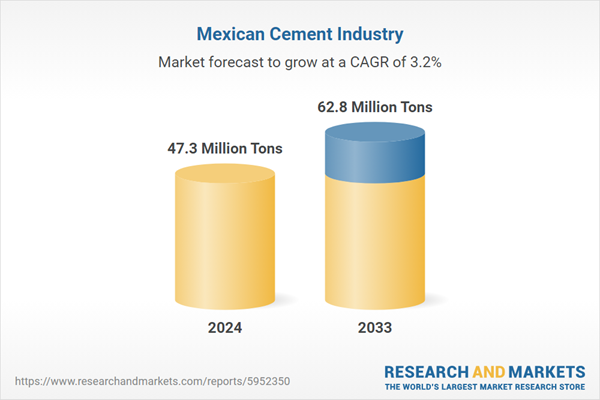Since NAFTA came into effect in 1994, the volume of trade between the U.S., Mexico, and Canada has realized phenomenal growth.
From a manufacturing perspective, the impact of NAFTA on the Mexican economy has been generally positive. After the agreement was signed, many foreign manufacturing companies entered in force, opening new manufacturing plants near the Mexican border. According to the publisher's market research, a large number of factories are relocating or planning to relocate from China to the U.S.-Mexico border in recent years. For the cement industry in Mexico, there are good opportunities for growth in the coming years.
The construction of industrial properties such as factories and warehouses, as well as the construction of infrastructure such as roads, will contribute to the rising demand for cement in the Mexican market.
Mexico cement industry stands as a cornerstone of the nation's infrastructure development, playing a vital role in fueling construction projects across the country. Characterized by a mix of domestic and international players, the industry boasts a rich history rooted in both traditional craftsmanship and modern technological advancements.
In Mexico, the cement industry remains highly concentrated, with six key companies holding sway over the national market. These companies, namely Cemex, Grupo Cementos Chihuahua, Cemento Moctezuma, Holcim-Apasco, Cruz Azul, and Cementos Fortaleza, collectively wield significant influence. Their combined production capacity amounts to approximately 55 million tons per year, distributed across 35 cement plants strategically positioned throughout the country.
The cement market is currently navigating a landscape of both potential and volatility, largely driven by the infrastructural demands of fast-developing economies despite global economic uncertainties. With about two-thirds of global cement consumption attributed to the construction sector, the market's stability is closely linked to overall economic activity. However, this consistent expansion also exposes the industry to cyclical risks and fluctuations in raw material costs.
Despite these challenges, several factors contribute to the vitality of the cement market. Urbanization, infrastructure development, and the growing need for housing are significant drivers of growth, especially in regions like Asia-Pacific, Africa, and South America. However, environmental concerns and stricter regulatory measures may pose limitations on future expansion efforts.
Furthermore, the significance of the cement industry transcends mere production statistics; it serves as a cornerstone of Mexico's economic advancement and societal advancement. As Mexico continues its journey of urbanization and modernization, the demand for cement remains steadfastly high, underpinning a myriad of infrastructure endeavors vital for progress, including factory buildings, residential complexes, commercial edifices, highways, and bridges.
According to the publisher's forecast, Mexico's cement production will rise from 47.3 million tons in 2024 to 62.8 million tons in 2033, a CAGR of 3.2% from 2024 to 2033.
According to the publisher, the growth of the Mexican cement industry is driven by the rising population of Mexico, which contributes to the rising demand for housing and infrastructure, as well as the large number of foreign companies investing in Mexico, which contributes to the rising demand for industrial real estate such as factories and warehouses.
Topics covered:
- Mexico Cement Industry Overview
- Economic environment and policy environment of cements in Mexico
- Mexico cement market size from 2019 to 2023
- Analysis of major Mexico cement manufacturers
- Key Drivers and Market Opportunities of Mexico’s Cement Industry
- What are the key drivers, challenges and opportunities for the Mexico cement industry during the forecast period 2024-2033?
- What is the expected revenue of the Mexico Cement market during the forecast period 2024-2033?
- What strategies are adopted by the key players in the market to increase their market share in the industry?
- Which segment of the Mexico Cement Market is expected to dominate the market in 2033?
- Mexico Cement Market Forecast from 2024 to 2033
- What are the main headwinds facing Mexico’s cement industry?
Table of Contents
Companies Mentioned
- Cemex
- GCC SAB de
- Cemento y Concreto Moctezuma
- Holcim-Apasco
- Cementos y Concretos Nacionales
- Cementos Fortaleza
Methodology
Background research defines the range of products and industries, which proposes the key points of the research. Proper classification will help clients understand the industry and products in the report.
Secondhand material research is a necessary way to push the project into fast progress. The analyst always chooses the data source carefully. Most secondhand data they quote is sourced from an authority in a specific industry or public data source from governments, industrial associations, etc. For some new or niche fields, they also "double-check" data sources and logics before they show them to clients.
Primary research is the key to solve questions, which largely influence the research outputs. The analyst may use methods like mathematics, logical reasoning, scenario thinking, to confirm key data and make the data credible.
The data model is an important analysis method. Calculating through data models with different factors weights can guarantee the outputs objective.
The analyst optimizes the following methods and steps in executing research projects and also forms many special information gathering and processing methods.
1. Analyze the life cycle of the industry to understand the development phase and space.
2. Grasp the key indexes evaluating the market to position clients in the market and formulate development plans
3. Economic, political, social and cultural factors
4. Competitors like a mirror that reflects the overall market and also market differences.
5. Inside and outside the industry, upstream and downstream of the industry chain, show inner competitions
6. Proper estimation of the future is good guidance for strategic planning.

LOADING...
Table Information
| Report Attribute | Details |
|---|---|
| No. of Pages | 60 |
| Published | April 2024 |
| Forecast Period | 2024 - 2033 |
| Estimated Market Value in 2024 | 47.3 Million Tons |
| Forecasted Market Value by 2033 | 62.8 Million Tons |
| Compound Annual Growth Rate | 3.2% |
| Regions Covered | Mexico |
| No. of Companies Mentioned | 6 |









